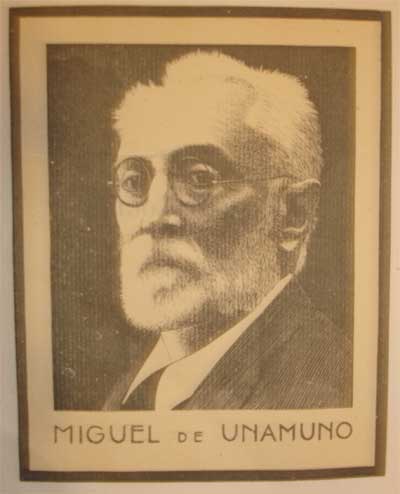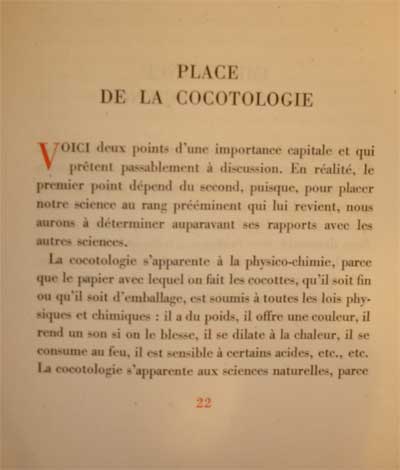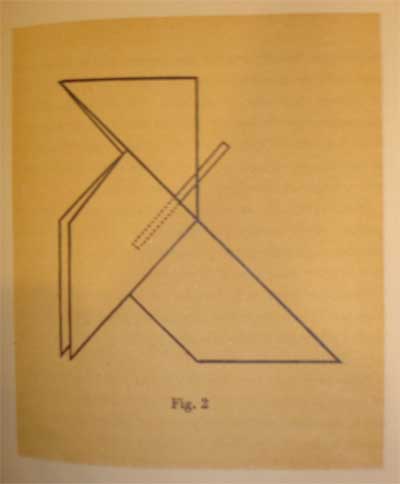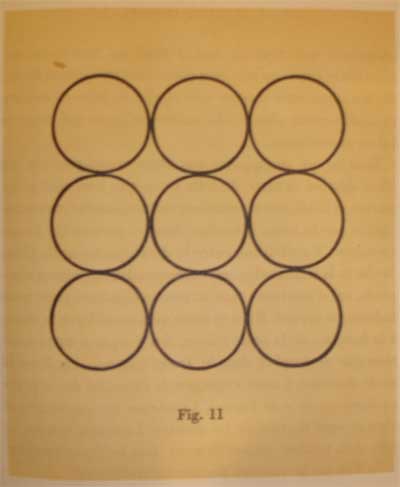by Akira Yoshizawa







origami with DaVinci robot - YouTube | |
www.youtube.com/watch?v...Share
30 Nov 2006 - 1 min - Uploaded by gombelloJapanese surgeon making origami with DaVinci robot. | |
Houdini's Paper Magic
The whole art of performing with paper, including paper tearing, paper folding and paper puzzles. Houdini describes in detail the methods of performing a myriad of paper tricks, such as cigarette paper tear, production of confetti, floating ball, ring and program, ballot or pellet test, shaving stick, Japanese butterflies, and many others.
|
Folding Theory
Posted in Beinecke Library, General Modern Collection by beineckepoetry on January 7, 2008
From La Cocotologie: Notes pour un Traité by Miguel de Unamuno (Paris, 1946).
A detailed philosophical essay on origami, with engravings by Gérard Angiolini. (Translated into French, after the 1902 Spanish original in Unamuno’s Amor y Pedagogia, a satirical novel on the excesses of positivism.)     
Origami in Fine Art
Yesterday I received a private e-mail asking if I knew of any early paintings which incorporated paperfolding. I thought that my reply might be of interest to subscribers to Origami-L, so here it is.I am asked if I know of any early paintings which incorporate folded paper figures as part of the background or foreground detail. My enquirer has a vague recollection of having seen a European painting which incorporates a small "pajarita". He studied art history many years ago, but has been unable to locate a reference to such a picture. One picture which depicts a pajarita is "The Merrymakers" by Carolus Duran of Paris, dated 1870, which is in the collection of the Detroit Institute of Arts. This picture shows a group of three women sitting found a table entertaining a child of about 18 months who sits on the lap of one of the women. On the table are an apparently live bird with a long tail and also a traditional paper pajarita which the woman sitting opposite the child is holding. This picture is reproduced on the front page of the Newsletter of The Friends of the Origami Center of North America for the Fall of 1989. It will probably be known that the Friends of the Origami Center are now known as Origami USA and the name of the Newsletter has been changed to "The Paper". I do not know whether copies of this issue are still available. There are also two paintings of the Spanish poet and philosopher Miguel de Unamuno, who died in 1936 at the beginning of the Spanish Civil War. Both are by Ignacio Zuloaga y Zamora and depict Unamuno's angular paperfolds of birds. They were created by Unamuno in the early years of the 20th Century, and anticipated by some twenty or thirty years some of the techniques of the later Japanese folder, Akira Yoshizawa, who is credited with revolutionising the art of paperfolding.  I do not know the actual sizes of the two paintings. Painting A is reproduced in black and white in "The Art of Origami" by Samuel Randlett (1961) and it shows Unamuno with two of his paper birds. I do not know where the original painting is kept. Randlett does not give his source or any acknowledgement. I also, separately, have a photograph of painting A in colour, which shows it to be in horizontal format. I recently received copies of reproductions of both paintings from David Brill, to whom they had been given by Juan Gimeno of Spain a few years ago. The reproduction of painting A is, again, in black and white, but that of painting B is in colour and shows it to be in vertical format. It includes only one single paper bird. The two paintings both seem to be "finished" works and while the compositions of the two paintings, with Unamuno sitting at his desk are broadly similar, neither seems to be a sketch for the other. There is no further information about where the original paintings are kept. I do not know the actual sizes of the two paintings. Painting A is reproduced in black and white in "The Art of Origami" by Samuel Randlett (1961) and it shows Unamuno with two of his paper birds. I do not know where the original painting is kept. Randlett does not give his source or any acknowledgement. I also, separately, have a photograph of painting A in colour, which shows it to be in horizontal format. I recently received copies of reproductions of both paintings from David Brill, to whom they had been given by Juan Gimeno of Spain a few years ago. The reproduction of painting A is, again, in black and white, but that of painting B is in colour and shows it to be in vertical format. It includes only one single paper bird. The two paintings both seem to be "finished" works and while the compositions of the two paintings, with Unamuno sitting at his desk are broadly similar, neither seems to be a sketch for the other. There is no further information about where the original paintings are kept.Many years ago someone asked me about a painting in the Louvre, in Paris, which she understood depicted a paperfold. At one time I made a fairly detailed study of the paintings in the Louvre, but I do not remember ever coming across such a picture. It may have been that the enquirer was confusing it with the painting at Detroit which was by Carolus Duran who resided in Paris. Origami is quite frequently depicted in Japanese prints, often of exquisite quality, of the 18th and 19th centuries. So far as I know, there is no book of reproductions of them in English, but there is a large A4 sized booklet in Japanese which depicts a fair collection of them. This is by Satoshi Takagi and the translation of the tittle is sometimes given as "Origami from the Classics". The booklet was published in 1993 by the Nippon Origami Association and is probably still obtainable from them. In October, 1999 there was an exhibition on the history of origami held in Tatsuno, Japan. The Japanese historian of origami, Masao Okamura wrote the text for a really splendid catalogue of the exhibition. Although I cannot read the text (how I wish I could!), I can appreciate the magnificent illustrations which are mostly in full colour. This book, too, gives a good selection of Japanese prints depicting origami, along with much other iterating matter. If anyone know of any other illustrations of origami in works of fine art, I shall be very grateful for the information. David Lister Grimsby, England. Au début était la Cocotte : ""Traité de cocotologie"".Miguel de Unamuno, TRAITE DE COCOTOLOGIE, présenté par Fernando Arrabal. Les Editions de Paris, 124 pp., 100 F.5 janvier 1995 à 00:35
Par MAGGIORI ROBERT
Les cocottes en papier. Et pourquoi pas une phénoménologie des
morpions? Trouverait-on jamais dans l'oeuvre de Heidegger une étude du jeu de quilles, ou, dans celle de Kierkegaard, un «Traité des quatre coins et de la marelle»? Quel penseur saugrenu peut bien avoir écrit sur les cocottes? Eh bien, l'un des plus grands philosophes espagnols, l'auteur de l'Agonie du christianisme et du Sentiment tragique de la vie, le recteur de l'université de Salamanque: Miguel de Unamuno! Gag? Peut-être, mais le livre est là, en bonne et due forme, préfacé ce qui n'est pas pour réduire l'extravagance par Fernando Arrabal, et s'intitule: Traité de cocotologie. Et il n'y a pas d'erreur: la cocotologie n'est pas l'étude des cocotiers, ni la science des mauvaises odeurs, ni la technique de fabrication des autocuiseurs, ni l'art d'approcher les filles de joie, mais bien la nouvelle et éminente discipline, qui s'applique à révéler tous les mystères des petits oiseaux que l'on fabrique par pliage de papier et qui eût pu s'appeler papyrornithologie si le terme n'avait fait mauvais genre.
Miguel de Unamuno a donc écrit un Traité de cocotologie. En réalité, sous ce titre invraisemblable sont réunis des «Apuntes para un tratado de cocotología», notes rédigées en 1910 et publiées en 1934 comme complément au roman Amor y pedagogía, une «Histoire de cocottes de papier» (1888), et deux autres articles sur les jeux d'échecs, l'un publié dans la revue argentine Caras y Caretas (1922), l'autre tiré du recueil d'essais Contra esto y aquello (1912). L'essentiel du savoir cocotologique se trouve dans les «Notes», écrites avec une emphase ironiquement académique et attribuées par Unanumo à un certain don Fulgencio Entrambosmares qui est un personnage de l'un de ses romans ainsi que dans l'«Histoire», contenant plutôt, comme autant de métaphores, l'évocation de souvenirs d'enfance et d'âpres batailles d'infanterie et d'aviation cocotesques.
José Ortega y Gasset, l'autre grand de la pensée ibérique, a dit ceci d'Unamuno: «Quoique sa méthode ne m'attire pas, je suis le premier à admirer l'étrange attrait de sa figure, silhouette démesurée de mystique énergumène qui se dresse sur le fond sinistre et stérile de l'abrutissement péninsulaire...» Et Antonio Machado: «Dans notre monde intellectuel (1905), personne ne suscite autant la guerre que la savant Unamuno. Un esprit batailleur, expansif et généreux, habite cet homme quichottesque...» Quant aux manuels d'histoire de la pensée, ils présentent sa philosophie, inspirée de Pascal, de Spinoza, et de Kierkegaard, comme une critique radicale des insuffisances du rationalisme et de l'idéalisme, et une valorisation «existentialiste» de l'individu concret, en proie à une viscérale «soif d'éternité» et immergé dans la douleur et les contradictions du «vécu». Les cocottes en papier, on le voit, n'apparaissent pas tout de suite.
Né à Bilbao le 27 septembre 1864, Unamuno fait ses études à Madrid et obtient son doctorat en 1884. Mais l'université lui fait mille tracas. Trop original, déjà plus savant que ses maîtres, peu respectueux des «auteurs au programme», sympathisant socialiste, rédacteur du journal la Lutte des classes, il n'obtiendra la chaire de grec, à Salamanque, qu'en 1891. La même année, Unanumo épouse Conceptión Lizárraga, qu'il avait secrètement choisie dès l'âge de 14 ans. Il aura d'elle neuf enfants. En 1897, il est atteint d'une maladie cardiaque dont il ne guérira jamais complètement et qui sera l'occasion d'une profonde crise religieuse, comme l'atteste son Journal intime (1), presque entièrement parcouru par les problèmes de la foi (qu'il perdra plus tard), la souffrance, l'au-delà, le Dieu-amour, le salut par Jésus Christ. La fuite en goélette Toujours suspect aux hommes de pouvoir et d'Eglise en raison de sa force polémique, son esprit d'indépendance et son... sale caractère, Don Miguel est quand même nommé en 1900 recteur de l'université de Salamanque. Il est destitué de sa charge en 1914, pour hostilité à la monarchie. Les articles qu'il écrit contre la dictature de Primo de Rivera, «oie royale», sont d'une telle virulence qu'il est finalement exilé à l'île de Fuerteventura, aux Canaries, d'où il s'enfuira à bord d'une goélette française. Il séjourne alors à Paris, puis, pour être plus près de l'Espagne, se fixe en 1925 à Hendaye. Revenu à Salamanque après la proclamation de la Seconde République, le 14 avril 1931, il retrouve son poste de recteur et est élu député. Il a alors une influence exceptionnelle sur la vie culturelle et politique de son pays. En 1936, contraint au silence, il exhibe devant les troupes franquistes qui occupent sa ville, une affiche ainsi rédigée: «Il est des moments où se taire, c'est mentir. Il ne suffit pas de vaincre, il faut convaincre.» Assigné à résidence, il meurt le 31 décembre 1936.
Unamuno a produit, dit-on, autant que Balzac. Mais ce qui étonne, c'est moins la quantité que la diversité, la polymorphie de l'oeuvre: helléniste, philosophe, historien, journaliste, homme politique, linguiste il lisait quasiment toutes les langues européennes, et apprit le danois juste pour lire Kierkegaard , Unamuno a écrit des essais, des romans, de nombreux recueils de poésie, des nouvelles, des oeuvres philosophiques, des pièces de théâtre, des contes, des discours et échangé une abondante correspondance. Du lyrisme bouleversant du Christ de Velázquez ou des subtilités de la Vie de don Quichotte et de Sancho Pança, on pourrait arriver à la veine comique du Traité de cocotologie.
Une expérience proche du nirvana Pourquoi comique, d'ailleurs? La cocotologie ne relève pas de la pochade, c'est une science de «très haute portée, ouvrant les plus vastes horizons à la pensée humaine, et l'entraînant dans de sublimes contemplations». Plier et replier de ses doigts agiles la feuille de papier est une expérience proche du nirvana, parce qu'elle révèle la Perfection. Et on se demande même, à condition de ne pas suivre ce benêt de Darwin qui du gallinacé fait un produit de l'évolution, si la cocotte ne vient pas avant l'Enfant, avant l'Homme, tant elle ressemble à l'Objet Premier, au Prototype Incréé. Au début était la Cocotte, non le Verbe! Aussi faut-il commencer par «étudier l'embryologie de la cocotte en partant du carré primitif de papier, qui issu du protoplasme papyracé, est l'ovule d'où la cocotte se développera», puis continuer par la physique, la dynamique, l'anatomie, la physiologie, la sexualité de la cocotte: «si, au moment du second pliage des côtés, on rabat les petites côtes vers l'extérieur, de manière dermatosquelettique, au lieu de les laisser à l'intérieur, on verra apparaître le sexe, d'abord indifférencié, puis différencié»: neutre, hermaphrodite, femelle, mâle. De façon à mettre en évidence l'«admirable, providentielle et téléologique harmonie» de la cocotte, un être «triangulo-rectangulo-isocèlique» qui contient même en son sein diagonal l'incommensurabilité de racine de 2 et ne peut donc que participer d'une «Intelligence créatrice et ordonnatrice» mettant directement l'homme en contact avec la Transcendance, non mais. Si le monde, comme le pensait Galilée, est écrit en caractères mathématiques, la poulette en papier en est bien le dictionnaire! Et dire que certains commentateurs ont vu en Unamuno un critique de l'esprit de système, de l'ordre rationnel, de l'abstraction des sciences, alors que tout le Traité de cocotologie montre à quel point de vérité mathématique aboutit l'étude de la cocotte, même vue de profil de cette cocotte sous laquelle Unamuno, enfant, collait par les ailes une mouche qui la faisait, vvrrmm, s'envoler.- Robert MAGGIORI 1) Traduit par Paul Drochon, Le Cerf 1988.
MIGUEL DE UNAMUNO : TRAITÉ DE COCOTOLOGIEMIGUEL DE UNAMUNO : TRAITÉ DE COCOTOLOGIEUn livre, un jour - 01/02/1995 - 01min43s411 vues
Olivier BARROT, entouré de cocottes en papier, présente le livre de Miguel de Unamuno "Traité de Cocotologie", sorte de pastiche des traités scientifiques. (Editions de Paris).
|
Contents[hide] |
| Symbols for basic folds | |||||||||
| |||||||||
| Origami symbols | ||||||||||||||||||||||||
| ||||||||||||||||||||||||